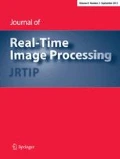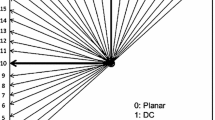Abstract
This paper presents an energy-aware scheme to reduce the energy consumption on the 3D high-efficiency video coding (3D-HEVC) depth maps prediction. Besides, a qualitative discussion is presented for intra- and inter-frame predictions that conduced to the proposition of a simple energy-aware scheme. Through our analysis, the HEVC intra-prediction is applied over homogeneous regions, whereas bipartition modes are preferred to encode edge regions. Based on this fact, the Simplified Edge Detector (SED) is proposed to employ a fast intra-mode decision. The SED anticipates the blocks that are likely to be better predicted by the HEVC intra-prediction, avoiding evaluations of bipartition modes. On inter-prediction, the TZ Search (TZS) is employed in the 3D-HEVC reference software (HTM) to encode both texture frames and depth maps. However, considering the depth maps properties, lightweight fast algorithms should be considered instead of TZS. Thus, fast algorithms such as Diamond Search, Small Diamond Search (SDSP), and One-at-a-Time Search were evaluated in this paper, aiming to reduce the complexity and energy, whereas sustaining good coding efficiency. By analyzing the depth channel, this scheme (considering intra- and inter-predictions) is able to provide an encoding time reduction of 21.2–23.1 %. As drawback, the combined solution increases the BD-rate in 0.62–0.87 %, in the synthesized views. When considering general-purpose processors, our solution is capable of providing a reduction in the energy consumption ranging between 9.85 and 10.41 %, according to our software analysis using the running average power limit. By using the SDSP combined of SED algorithm instead of HTM-10.2 baseline solution, it is possible to achieve a reduction of about 54 % in the energy consumption, and about 1.8 times in the power dissipation, when running on a dedicated hardware design. Considering that depth maps are only used for view synthesis, a subjective quality assessment was performed using synthesized views, and the results demonstrate that our solution presents minimum quality losses.











Similar content being viewed by others
References
Yasakethu, S.L.P., Fernando, W.A.C, Kamolrat, B., Kondoz, A.: Analyzing perceptual attributes of 3D video. IEEE Transactions on Consumer Electronics 55(2), 864–872 (2009)
JCT-3V. Available at: http://phenix.int-evry.fr/jct2/, Access in Aug. 2015
Zhang, L., et al.: 3D HEVC Test model 6. Document: JCT3V-F1005. Draft 6 of 3D-HEVC Test Model Description, Geneva (2013)
H.265: High Efficiency Video Coding. Available at: http://www.itu.int/rec/T-REC-H.265. Access in 2015
Smolic, A., et al.: Coding algorithms for 3DTV-A survey. IEEE TCSVT 17(11), 1606–1621 (2007)
Kauff, P., et al.: Depth map creation and image based rendering for advanced 3DTV services providing interoperability and scalability. Signal Process. Image Commun. 22(2), 217–234 (2007)
Smolic, A., et al.: Intermediate view interpolation based on multiview video plus depth for advanced 3D video systems. In: Proceedings of IEEE International Conference on Image Processing, San Diego, USA, pp. 2448–2451 (2008)
Rusanovskyy, D., et al.: Common test conditions of 3DV experimentation. ISO/IEC JTC1/SC29/WG11 MPEG2011/N12745, Geneva, Switzerland (2012)
Tang, X.L., Dai, S.K., Cai, C.H.: An Analysis of TZ Search Algorithm in JMVC, ICGCS, pp. 516–520 (2010)
Ahn, S., Lee, B., Kim M.: A Novel Fast CU Encoding Scheme based on Spatio-Temporal Encoding Parameters for HEVC Inter Coding. IEEE TCSVT 25(3), 422–435 (2014)
Zhang N., et al.: Fast encoder decision for texture coding in 3D-HEVC. Signal Process. Image Commun. 29(9), 951–961 (2014)
Shen, L.; et al.: Effective CU size decision for HEVC intracoding. IEEE Trans. Image Process. 23(10), 4232–4241 (2014)
Zhang, J., et al.: An efficient fast mode decision method for inter prediction in HEVC. IEEE Trans. Circuits Syst. Video Technol. (2015)
Gu, Z., et al.: Fast depth modeling mode selection for 3D HEVC depth intra coding. IEEE International Conference on Multimedia and Expo Workshops (ICMEW), San Jose (2013)
Mora, E., et al.: Initialization, limitation and predictive coding of the depth and texture quadtree in 3D-HEVC. IEEE TCSVT 24(9), 1554–1565 (2013)
Medhat, A., et al.: Fast Center Search Algorithm with Hardware Implementation for Motion Estimation in HEVC Encoder. ICECS, Marseille (2014)
Sinangil, M.E., et al.: Hardware-aware motion estimation search algorithm development for high-efficiency video coding (HEVC) standard. IEEE International Conference on Image Processing (ICIP), Orlando (2012)
Zhao, L., et al.: Fast Mode Decision Algorithm For Intra Prediction in HEVC, Visual Communications and Image Processing (VCIP), IEEE (2011)
Zhu, S., Ma, K.: A new diamond search algorithm for fast block-matching motion estimation. IEEE TIP 9(2), 287–290 (2000)
Zhu, C., Lin, X., Chau, L.: Hexagon-based pattern for fast block motion estimation. IEEE Trans. Circuits Syst. Video Technol. 12(5), 349–355 (2002)
Sanchez, G., et al.: DMPDS: a fast motion estimation algorithm targeting high resolution videos and its FPGA implementation. IJRC 2012, 1–12 (2012)
Sanchez, G., et al.: Complexity reduction for 3D-HEVC depth maps intra-frame prediction using simplified edge detector algorithm. In: 2014 IEEE ICIP, Paris (2014)
Srinivasan, R., Rao, K.R.: Predictive coding based on efficient motion estimation. IEEE Trans. Commun. COM- 33(8), 888–896 (1985)
Sanchez, G., et al.: Hardware-Friendly HEVC Motion Estimation: New Algorithms and Efficient VLSI Designs Targeting High Definition Videos. ALOG (Dordrecht. Online) 82(1), 135–146 (2014)
BJØNTEGAARD, G.: Calculation of average PSNR differences between RD curves. Document: VCEG-M33. Austin (2001)
David, H., et al.: RAPL: Memory Power Estimation and Capping. Austin (2010)
ITU - International Telecommunication Union. P.910: Subjective Video Quality Assessment Methods for Multimedia Applications, (2009)
Zatt, B., et al.: 3D Video Coding for Embedded Devices: Energy Efficient Algorithms and Architectures. Springer, New York (2013)
Author information
Authors and Affiliations
Corresponding author
Rights and permissions
About this article
Cite this article
Saldanha, M., Sanchez, G., Zatt, B. et al. Energy-aware scheme for the 3D-HEVC depth maps prediction. J Real-Time Image Proc 13, 55–69 (2017). https://doi.org/10.1007/s11554-016-0597-8
Received:
Accepted:
Published:
Issue Date:
DOI: https://doi.org/10.1007/s11554-016-0597-8




